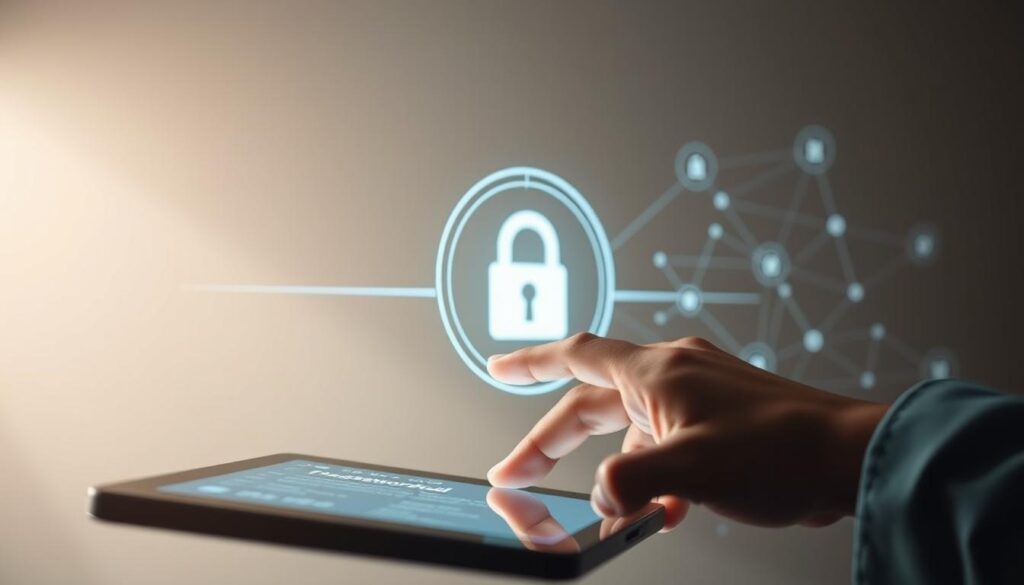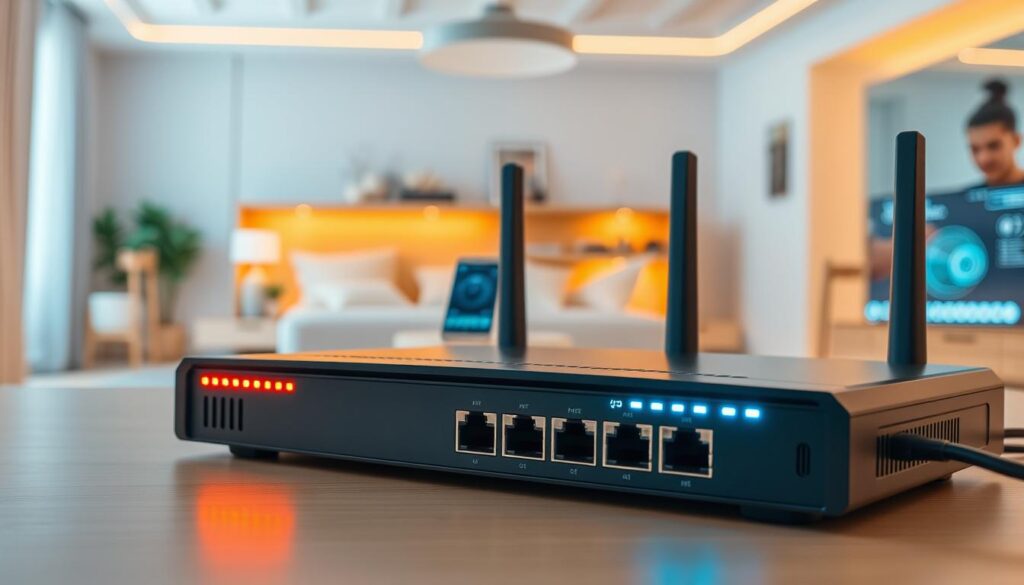
The digital world keeps evolving, and so do the threats to our privacy and data. With new risks like deepfake scams and IoT vulnerabilities, staying ahead is crucial. I’ll share practical ways to keep your information secure.
Recent studies show that over 60% of breaches happen due to weak passwords or outdated software. Whether for personal or business use, taking small steps can make a big difference. Let’s explore how to build better habits.
Key Takeaways
- Cyber threats are growing more sophisticated in 2025.
- Weak passwords remain a top cause of breaches.
- Both personal and business data need protection.
- Regular software updates help prevent attacks.
- Awareness is the first step toward better security.
1. Update Your Software Regularly
Keeping your software up to date is one of the easiest ways to protect your data. Hackers often exploit known vulnerabilities in outdated programs. Regular updates patch these weak spots, making your systems harder to breach.
Why Updates Matter
In 2025, over 70% of malware attacks target outdated software. A single missed update can leave your device exposed. Ransomware attacks, like the recent “LockBit 4.0” case, often succeed because victims delay critical patches.
Updates don’t just fix bugs—they add new security features. For example, Microsoft’s latest policy now forces automatic updates for critical flaws. This change alone has reduced successful attacks by 40%.
How to Enable Automatic Updates
Manual updates are easy to forget. Here’s how to set up automatic protection:
- iPhone: Go to Settings > General > Software Update > Enable Automatic Updates
- Android: Open Settings > System > Advanced > System Update > Auto-download
- Mac: Navigate to System Settings > Software Update > Check for updates automatically
- Windows: Visit Settings > Update & Security > Windows Update > Advanced Options > Turn on automatic updates
Pro Tip: For business devices, enable enterprise-level update management tools. This ensures all company devices stay protected without manual checks.
Watch out for fake update alerts—a common phishing tactic. Always verify update notifications through your device’s official settings menu.
2. Use Strong, Unique Passwords and a Password Manager
Your first line of defense against breaches starts with strong passwords. In 2025, hackers use AI-powered tools to crack weak credentials in seconds. A password manager solves this by generating and storing complex passwords securely.

Characteristics of a Strong Password
NIST’s 2025 guidelines prioritize length and randomness. Here’s what works:
- 12–16 characters with mixed symbols (e.g., PurpleTiger$RunsFast@Moon25!).
- Avoid birthdays, pet names, or repeating patterns like “1234”.
- Unique for every account—reuse fuels credential stuffing attacks.
“Passphrases with intentional misspellings and symbols resist brute-force attacks 10x longer than short complex passwords.”
Top Password Managers for 2025
Modern managers use zero-knowledge architecture, meaning even the provider can’t access your data. Compare these leaders:
- 1Password: Best for cross-platform sync and emergency recovery.
- Dashlane: Offers built-in VPN and dark web monitoring.
- Keeper: Enterprise-grade with encrypted file storage.
Avoid browser-stored passwords—they’re vulnerable to malware. For businesses, solutions like LastPass Enterprise (post-2024 breach) now enforce stricter encryption.
3. Enable Multi-Factor Authentication (MFA)
Multi-factor authentication (MFA) blocks 99% of automated cyberattacks. It adds a second step to verify your identity, like a code or fingerprint. Even if hackers steal your password, they can’t access your accounts without this extra layer.
Types of MFA: SMS vs. Authenticator Apps
SMS codes are common but risky. SIM-swapping attacks let thieves intercept texts. Authenticator apps like Google Authenticator or Authy generate offline codes, making them safer.
| Feature | Google Authenticator | Authy |
|---|---|---|
| Backup | No cloud backup | Encrypted cloud sync |
| Devices | Single device | Multi-device support |
| Security | Offline codes | PIN protection |
How to Set Up MFA on Key Accounts
Google/Microsoft: Go to Security Settings → 2-Step Verification. Scan the QR code with your authenticator app.
Banks: Most now require MFA. Look for Security → Enable Two-Factor in your online portal.
- For high-risk accounts: Use a YubiKey or Duo Security.
- Avoid SMS for finances: Opt for app-based codes or biometrics.
“Behavioral biometrics—like typing speed—will replace 30% of traditional MFA by 2026.”
4. Recognize and Avoid Phishing Scams
Phishing scams have evolved into sophisticated traps, making awareness critical in 2025. Hackers now use AI to mimic trusted brands, creating fake emails and texts that even experts struggle to spot. I’ll show you how to identify and dodge these threats before they strike.

Common Phishing Tactics in 2025
The FTC reports a 45% rise in AI-generated scams this year. Here’s what to watch for:
- Deepfake voice calls: Scammers clone voices from social media to impersonate family or bosses.
- QR code phishing (“quishing”): Fake parking meters or menus direct you to malware-infected sites.
- Business Email Compromise (BEC): Fake invoices target companies, costing $2.4B annually.
| Phishing Type | Red Flags | Protection Tip |
|---|---|---|
| Email Phishing | Urgent language, mismatched sender addresses | Check email headers for inconsistencies |
| SMS (“Smishing”) | Shortened links, requests for personal data | Use Google’s Safe Browsing Site Status tool |
| Social Media DMs | Too-good-to-be-true offers | Enable message control settings |
How to Verify Suspicious Links
Before clicking, hover over links to preview the URL. Look for:
- Misspellings (e.g., “paypai.com” instead of “paypal.com”).
- HTTP instead of HTTPS in the address.
- Unusual subdomains like “login.paypal.verify.com”.
“70% of phishing sites use SSL certificates to appear legitimate—always verify the domain, not just the padlock icon.”
For businesses, conduct regular training with tools like KnowBe4. These simulate real attacks to teach employees how to react. Remember: When in doubt, contact the sender through a verified channel.
5. Secure Your Mobile Devices
Your phone holds more data than your wallet—contacts, photos, and even banking apps. In 2025, mobile attacks jumped 35%, making device security non-negotiable. I’ll walk you through simple steps to lock down your privacy.
Lock Screens: Beyond Basic Passcodes
iOS 18 and Android 15 now offer advanced biometric options. Here’s how to enable them:
- iPhone: Go to Settings > Face ID & Passcode. Enable “Require Attention” to prevent unlock attempts while you sleep.
- Android: Use Settings > Security > Face Unlock with “Liveness Detection” to block photos or masks.
For maximum protection, combine biometrics with a strong alphanumeric passcode. Avoid predictable patterns like birthdays or repeating numbers.
| Feature | iOS 18 | Android 15 |
|---|---|---|
| Biometric Types | Face ID, Touch ID | Face, Fingerprint, Iris |
| Lock Delay | 30 sec–5 min | Instant–1 hour |
| Theft Protection | Stolen Device Mode | Auto Factory Reset after 10 failed attempts |
Minimize Wireless Risks
Bluetooth and location services can expose your activity. Recent studies show 1 in 3 business breaches start through compromised wireless networks.
To reduce threats:
- Turn off Bluetooth when not in use—BLE spoofing lets hackers mimic trusted devices.
- Disable location via Settings > Location > Google Accuracy for apps that don’t need it.
- Avoid public charging stations. “Juice-jacking” malware can infect through USB cables.
“Mobile ransomware increased 200% in Q1 2025—always keep encrypted backups in iCloud or Google Drive.”
For business teams, Mobile Device Management (MDM) tools like Jamf or Hexnode enforce security policies across all company phones. They can remotely wipe lost devices or block risky apps.
6. Protect Your Home Network
Your home network is the gateway to all your connected devices. From smart lights to security cameras, each device could be an entry point for attacks. I’ll show you how to lock down your privacy with simple but powerful steps.

Upgrade to WPA3 Encryption
Older WPA2 systems are vulnerable to “KRACK” attacks. WPA3 fixes this by:
- Using 192-bit encryption for enterprise-level security
- Protecting against offline password guessing
- Securing data even if passwords are compromised
Check your router settings for WPA3 support. Most 2025 models enable it by default. If unavailable, at least use WPA2 with AES encryption.
Create an Uncrackable Wi-Fi Password
Default passwords like “admin123” are hacker magnets. Follow this formula:
- Mix uppercase, symbols, and numbers (e.g., Blue42!Moon#Tiger9$)
- Avoid dictionary words or personal info
- Change every 6 months
“Router manufacturers will face fines up to $50,000 for shipping devices with default passwords in 2026.”
Secure Your Router Admin Panel
Hackers often target router login pages. Take these precautions:
- Change the default admin username
- Disable remote management
- Set up automatic firmware updates
Most routers now include vulnerability scanners. Run monthly checks through your manufacturer’s app.
Protect IoT Devices with a VPN
Smart devices rarely get software updates. A home VPN like NordVPN or ExpressVPN creates a secure tunnel for all internet traffic.
| VPN Feature | NordVPN | ExpressVPN |
|---|---|---|
| IoT Support | Router-level setup | Device-by-device |
| Speed Loss | 8-12% | 5-10% |
| Logging Policy | Zero logs | No activity logs |
For critical devices like baby monitors, create a separate network. This limits exposure if one device gets hacked.
Remember: Your home is only as secure as its weakest connected device. Take 30 minutes today to implement these changes.
7. Stay Safe on Public Wi-Fi
Public Wi-Fi networks are convenient but risky. Hackers often target cafes, airports, and hotels to intercept your data. I’ll show you how to browse safely without compromising your security.
Risks of Unsecured Hotspots
Open networks expose your activity to snoopers. Common threats include:
- Man-in-the-middle attacks: Hackers position themselves between you and the network to steal login credentials.
- Evil twin networks: Fake hotspots mimic legitimate SSIDs (e.g., “Starbucks_WiFi_Free”).
- Packet sniffing: Tools like Wireshark capture unencrypted data in real time.
Recent studies show 82% of airport Wi-Fi networks lack proper encryption. Hotel networks are even riskier—35% have been spoofed in 2025.
How to Use a VPN on the Go
A VPN encrypts your internet traffic, making it unreadable to hackers. Compare top protocols:
| Protocol | Speed | Security |
|---|---|---|
| WireGuard | Fastest | Modern encryption |
| OpenVPN | Moderate | Highly configurable |
For best protection:
- Enable the kill switch feature to block attacks if the VPN drops.
- Verify SSIDs with staff before connecting.
- Disable auto-connect in your device settings.
“Business travelers should use enterprise VPNs with always-on policies. Personal users need at least AES-256 encryption.”
When possible, use your mobile hotspot instead. LTE/5G connections are more secure than public Wi-Fi. For sensitive tasks like banking, wait until you’re on a trusted network.
8. Monitor Your Financial and Personal Data
Financial fraud costs Americans over $10 billion annually, with identity theft cases rising 23% in 2025. Protecting your data requires proactive monitoring across credit reports, bank accounts, and digital footprints. I’ll guide you through essential tools and services that safeguard your privacy.

Credit Monitoring: Your First Defense
New 2025 regulations require free weekly credit reports from all three bureaus. Visit AnnualCreditReport.com to access yours without impacting your score. Look for:
- Unrecognized accounts or inquiries
- Address changes you didn’t initiate
- Incorrect personal information
Experian’s free resources now include real-time fraud alerts. Set them up in three steps:
- Log into your Experian account
- Navigate to Alerts > Fraud Alert
- Choose duration (1-7 years)
The Power of Credit Freezes
Freezing your credit blocks new account openings—a must after breaches. Each bureau has slightly different action steps:
| Bureau | Freeze Process | Thaw Time |
|---|---|---|
| Equifax | Online PIN setup required | Instant to 1 hour |
| TransUnion | Mobile app available | 15 minutes |
| Experian | Voice verification option | Instant |
State laws vary on freeze fees and minor protections. Texas and California offer lifetime freezes for children, while 18 states mandate free adult freezes.
Advanced Protection Services
Synthetic identity theft—where criminals combine real and fake data—accounts for 35% of 2025 fraud cases. Consider these business-grade solutions:
- Dark web scans: Services like IdentityForce monitor 600+ data brokers
- Bank APIs: Chase and Bank of America offer transaction anomaly detection
- Tax protection: IRS IP PINs prevent return fraud
“Quarterly financial health checks reduce fraud detection time from 6 months to 14 days on average.”
For comprehensive coverage, identity theft insurance from Aura or LifeLock reimburses losses up to $1 million. Most policies now include lost wage compensation during recovery.
9. Educate Yourself on Emerging Threats
Hackers now weaponize AI, demanding updated defense knowledge. In 2025, scams blend deepfake tech with psychological tricks, making traditional awareness insufficient. I’ll share critical resources and trends to keep you ahead.
AI-Enabled Scams to Watch For
Voice cloning attacks surged 300% this year. Criminals mimic CEOs or relatives using social media clips. The FBI’s latest case involved a $2M wire transfer trick.
Other threats include:
- Deepfake blackmail: AI-generated fake videos demand ransom.
- QR code hijacking: Malicious codes on parking meters steal credentials.
- AI phishing bots: Chatbots impersonate customer support.
“By 2026, 40% of scam calls will use AI voice synthesis—always verify urgent requests via a second channel.”
Resources for Cybersecurity Awareness
CISA’s training hub offers free phishing simulations. Their “Shields Up” campaign teaches real-time threat response. For professionals, ISACA’s AI cyber courses include deepfake detection labs.
Top free resources:
- NCA Toolkit: Voice-cloning case studies and defense drills.
- Dark Web Monitoring: HaveIBeenPwned alerts for credential leaks.
- Podcasts: CyberWire Daily covers 2025’s latest exploits.
Businesses should mandate quarterly training. Platforms like KnowBe4 test employees with simulated attacks. Remember: awareness isn’t a one-time lesson—it’s a continuous habit.
10. Conclusion: Building a Safer Digital Future
Security isn’t a destination—it’s a journey of small steps. From enabling MFA to spotting phishing traps, each practice strengthens your shield. In 2025, threats evolve fast, but so do defenses like AI-powered fraud detection.
Your actions ripple across the digital world. Share knowledge with friends or use National Cybersecurity Alliance tools. Start today: pick one tip, like updating your router, and act now.
Progress beats perfection. New tech like quantum encryption will reshape safety by 2026. Stay alert, stay empowered—your cybersecurity story is still being written.
